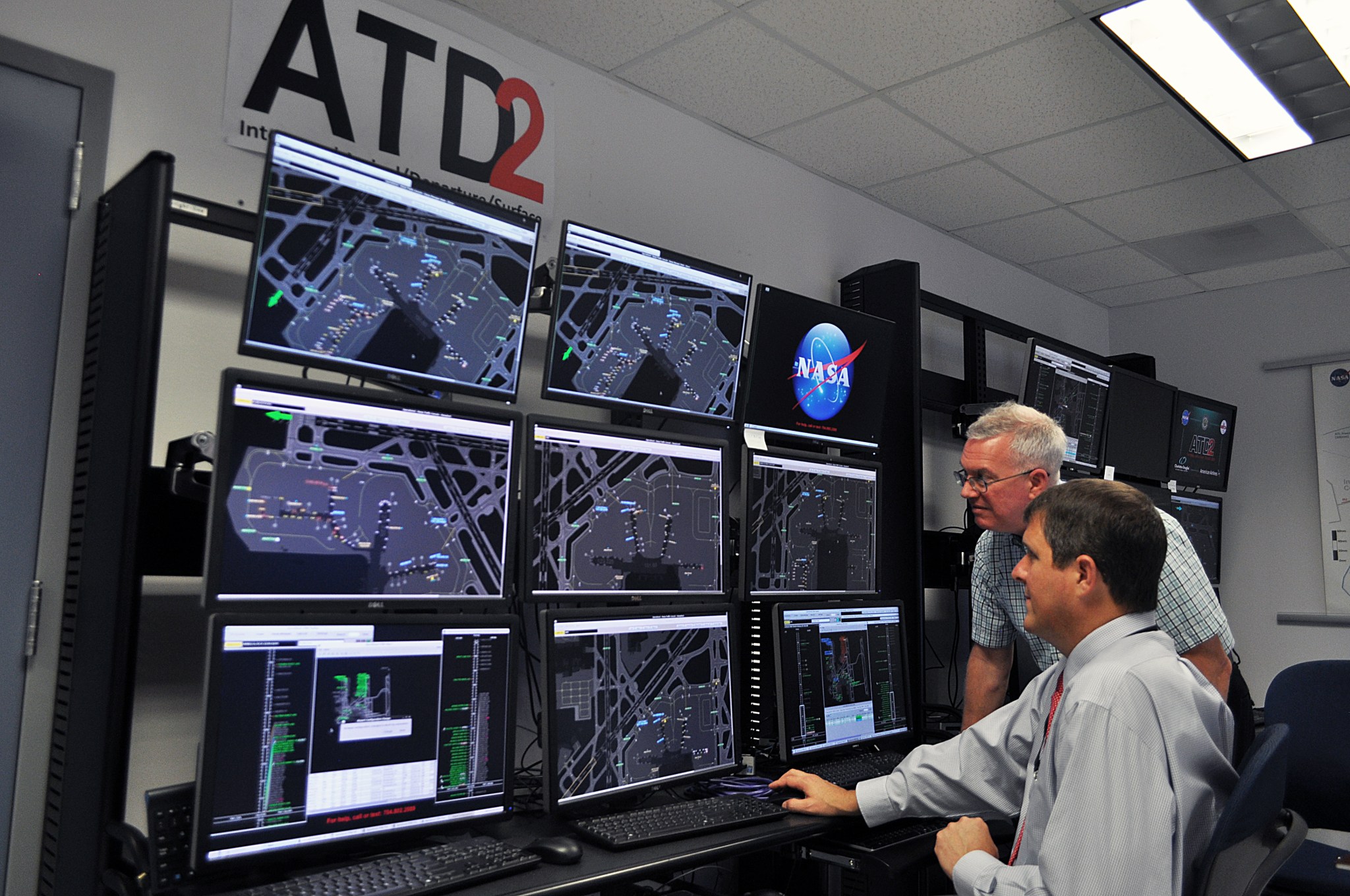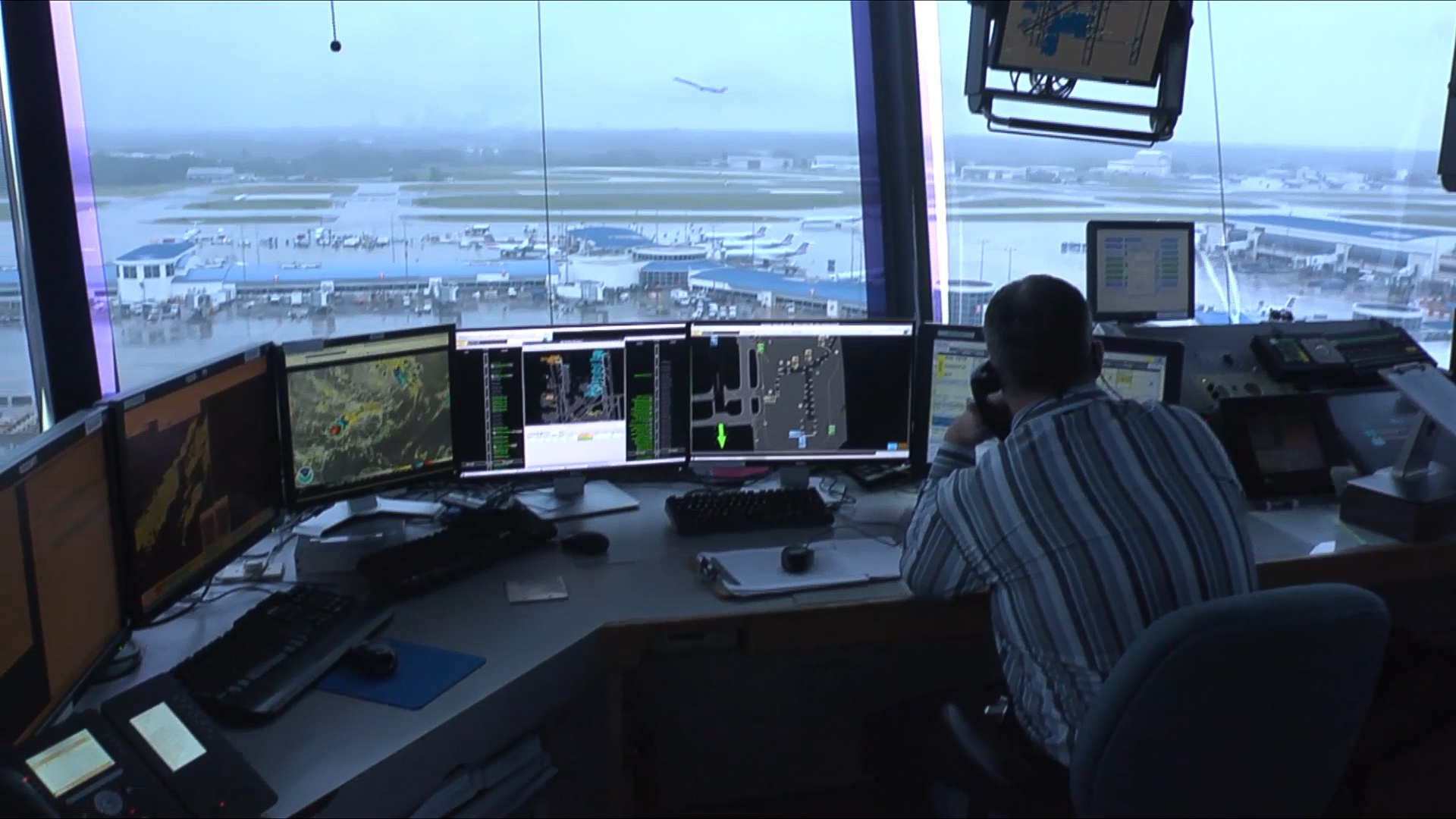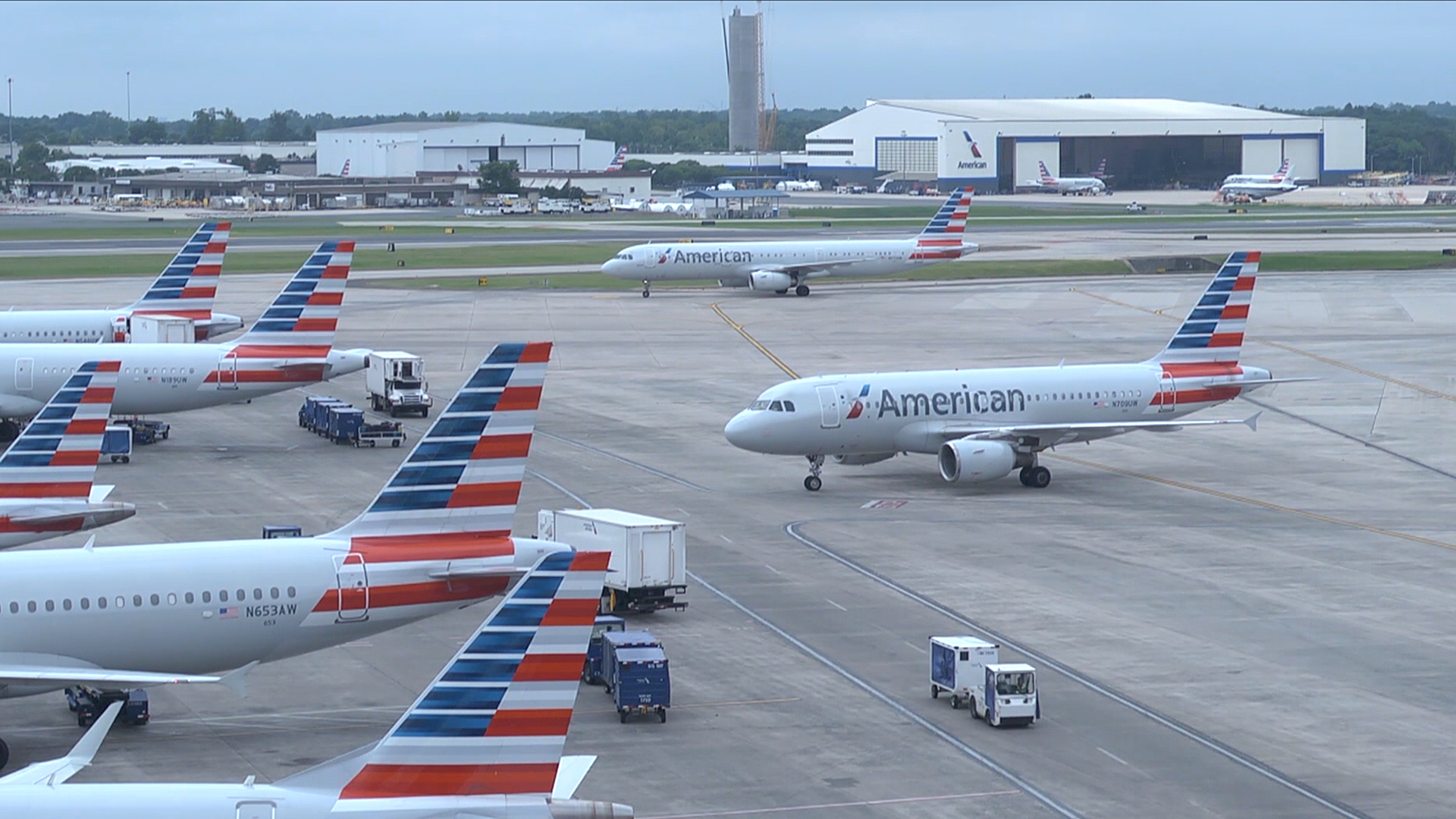
Two years into a three-year demonstration of new technology for more efficiently scheduling takeoffs at a major airport, NASA researchers already have seen the system generate results benefitting participating airlines and their passengers.
The focus of the research – known as Airspace Technology Demonstration-2, or ATD-2 – is on enabling the coordination of schedules among those who manage the movement of aircraft from an airport gate to a spot in the sky after takeoff where they can safely join with the overhead traffic – like a car merging onto a freeway.
The big idea is to more reliably predict and schedule the time when aircraft are pushed back from their gates so they can get to the runway and take off without pausing to sit on an airport taxiway, waiting their turn in line while burning fuel and passengers’ patience.
Working with the Federal Aviation Administration (FAA), the air traffic controllers union, and American Airlines at Charlotte-Douglas International Airport in North Carolina – the sixth busiest in the nation by aircraft traffic – NASA began testing the new traffic management tools in September 2017.
“With ATD-2 we’ve demonstrated during the past two years we’re able to move aircraft in a more efficient manner, which is resulting in time saved, fuel saved, and less CO2 released,” said Shawn Engelland, NASA’s ATD project manager.
NASA’s aeronautical innovators have the numbers to back up Engelland’s statement. Since the demonstration began in 2017 through September 30, 2019, ATD-2 has led to these results for the airlines and flying public:
- Burned 3,101,434 less pounds of jet fuel. (Airlines measure fuel in pounds as the weight of a gallon of jet fuel can vary by temperature, but in general that figure represents about 462,000 gallons – enough to fill this writer’s Ford Explorer’s gas tank 23,000 times if the aviation fuel wouldn’t wreck the engine.)
- Prevented the release of carbon dioxide equivalent to the 71,031 trees you would have to plant in an urban environment to otherwise offset that amount of emissions.
- Reduced jet engine runtime by 2,448 hours, which can help increase engine life and lengthen time between scheduled maintenance.
- Saved 414.4 hours of surface delay time, which is less time sitting going nowhere.
More Benefits to Come
Some of the biggest potential benefits are still to come, Engelland said, and the hint of what those might be are teased at with the 414.4 hours of surface delay time saved that ATD-2 has documented during the past two years.
“What we’ve seen in terms of benefits with ATD-2 has been impressive so far, but it only scratches the surface of what might be possible once these tools are fully implemented by the FAA and industry at major airports across the nation,” Engelland said.
Representatives from the FAA agree, with John Short – an FAA traffic management specialist who is the National Air Traffic Controllers Association representative on the ATD-2 project – saying the partnership among NASA and the controllers “has been fantastic.”
“They have provided the controllers and the traffic management specialists with tools to improve their job, and to improve their ability to make better decisions. NASA’s team has been always open and willing to change on the fly with what the controllers need,” Short said.
Once again, the key to all of this is the ability to coordinate scheduling among all those who control the movement of aircraft in areas they are responsible for.
“Everybody has to play their part with it,” said Michael Hoprich, an FAA traffic management coordinator at Charlotte. “If one side drops the ball it’s not going to work like it’s been performing.”
It starts with the reality that both the airlines and the FAA have built extra time into the parts of the flight schedules they manage. The reason: uncertainties inherent in an aging national airspace system, which in many places still uses paper strips and talking on a telephone to coordinate air traffic.
“We’ve all experienced it. You depart an airport late and you still get to your destination airport early because the airlines and the FAA have padded so much time into their schedules to deal with the uncertainty,” Engelland said.
With ATD-2, these new scheduling tools make it possible to nail down exactly when an aircraft should depart its gate.
“Once you get to a more predictable operation, which we’ve been able to demonstrate at Charlotte, then those pads can start being reduced on both the FAA side and the airline side,” Engelland said.
That could result in a big payoff for the airlines. By reliably reducing the padding in a schedule, an airline could theoretically schedule another revenue-producing flight for a particular aircraft after picking up enough time.
“That would be huge for an airline if you can do that,” Engelland said.
For now, the benefit of improving the predictability of the push back time is demonstrated by the numbers mentioned earlier. Given that the extra padding is still present in the flight schedules, those benefits are being realized by keeping the airliner at the terminal until it’s time to go.
On average, with ATD-2 that extra time at the gate at Charlotte for those aircraft involved has run just shy of six minutes – time they would have spent waiting on a taxiway burning fuel and releasing emissions.
Instead, that gate hold meant six minutes without the engines on could have helped someone make a connecting flight they might have otherwise missed or could have given the airline more time to get additional baggage onboard from another flight that was delayed.
“There were some concerns among those involved that this new tool would require long holds at the gate or ramp before the flight was allowed to taxi to the runway, but our experience at Charlotte alleviated those concerns,” Engelland said.
Final Phase Ready
ATD-2 – one of three Airspace Technology Demonstrations projects managed by NASA’s Airspace Operations and Safety Program – was set up to be a three-year demonstration and included three phases of increasingly more sophisticated capability and scope.
Phase One began in September 2017, introducing the tools and folding in the participation of the FAA’s various air traffic control and management facilities that oversee traffic in and out of Charlotte. Also involved was American Airlines, which directs aircraft surface movements near the airport’s terminal building on behalf of all the airlines there.
Phase Two expanded the scope of the demonstration to include the FAA’s Air Route Traffic Control Center based in Atlanta, which borders the Washington center based in Virginia that was included in Phase One. In addition to a geographic expansion of the demonstration, Phase Two also introduced five new technical capabilities.
Phase Three will focus on coordinating air traffic departing Dallas/Ft. Worth International airport and nearby Dallas Love Field airport and will see Southwest Airlines join American Airlines as participants. Phase Three officially began this month, although the system was put through its paces in a sort of “soft open” earlier in the year.
“We chose the two airports in North Texas because they represent the challenge of managing air traffic over metropolitan areas that have multiple airports so close together,” Engelland said.
Because of their proximity, the two airports must share limited airspace; so, the tools associated with ATD-2 and used to coordinate departures at a single airport will be put through their paces as both North Texas airports attempt to feed air traffic to the same highways in the sky at the same time.
“What we’re doing with Phase Three is building a multi-airport scheduler that looks at the departures coming off those two surfaces, creates a common schedule, and then provides advisories on the smartest way to get the aircraft off of those airports, given the constraints of the airspace,” Engelland said.
Although helpful year-round, ATD-2’s maximum benefit for the North Texas demonstration won’t come until the more active weather season occurs next spring and summer, when thunderstorms tend to wreak havoc with airline schedules and on-time departures and arrivals.
“As we did with the first two phases at Charlotte, we’ve been taking a crawl/walk/run approach to preparing for and executing this final phase of ATD-2,” Engelland said, noting the research team used the 2019 storm season to gather data in North Texas for use in finalizing their operational plans for 2020.
And while there will be much attention paid to North Texas during Phase Three, ATD-2 will continue to exercise and evaluate its resources and operations at Charlotte as the full demonstration continues through its final year.
“With at least seven different facilities in various locations involved – all of which have their own staff, hardware configurations, and operational responsibilities – it’s a pretty ambitious undertaking,” Engelland said.
Sharing the Technology
With an eye to that future when ATD-2 has finished its work and the technology is considered ready for prime time, NASA researchers are eager to share what they’ve learned with those who will be able to turn the experimental into the operational.
To that end, NASA Aeronautics hosted an Industry Workshop in Dallas during September to update the aviation community on ATD-2’s progress to date and to discuss the technical requirements industry must know to help them prepare for future business opportunities.
In general, here’s the plan:
Once ATD-2 is wrapped up, a final package of knowledge and technology will be turned over to the FAA for their continued evaluation, certification, and deployment as part of their Terminal Flight Data Manager (TFDM) program.
“We’ve already transferred a great deal of knowledge and some technology to the FAA for TFDM in both informal and formal ways. One package was delivered in 2018 and another was delivered September 30,” Engelland said. That second packaged included more than 4,000 pages of documentation and many hours of video.
The FAA already has the budget approved and is building TFDM with plans to roll it out to 27 major airports, Engelland said. That rollout will be a fully equipped kind of thing that includes hardware, software, and the data stream that makes the FAA side of the operation work.
Meanwhile, since it is the airlines or the airport itself that manages the non-FAA-controlled part of the airport ramp – which includes the terminal gates – they must procure the system that interfaces with the FAA system. The FAA will provide the data stream, but not the hardware or software.
This is why the recent Industry Workshop was so helpful to everyone involved.
NASA’s ATD-2 project provides one example of how to interface with the FAA’s TFDM. By sharing that technology and experience with industry, they will begin to be equipped with the information they need to develop their own solutions and make them available as potential vendors to the airlines and airports who will become customers.
“So, with this conference and the library of information we have accumulated, NASA was trying to fulfill that future need by providing this technology transfer to anyone who is interested to help industry get ready,” Engelland said.




































